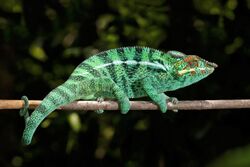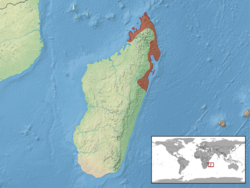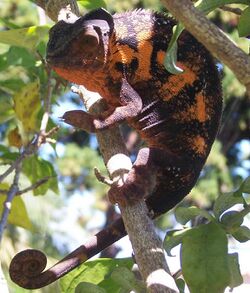Biology:Panther chameleon
| Panther chameleon | |
|---|---|

| |
| Male, Nosy Be locale | |
| Scientific classification | |
| Script error: No such module "Taxobox ranks".: | Animalia |
| Script error: No such module "Taxobox ranks".: | Chordata |
| Script error: No such module "Taxobox ranks".: | Reptilia |
| Script error: No such module "Taxobox ranks".: | Squamata |
| Script error: No such module "Taxobox ranks".: | Iguania |
| Script error: No such module "Taxobox ranks".: | Chamaeleonidae |
| Script error: No such module "Taxobox ranks".: | Furcifer |
| Script error: No such module "Taxobox ranks".: | <div style="display:inline" class="script error: no such module "taxobox ranks".">F. pardalis |
| Binomial name | |
| Furcifer pardalis (Cuvier, 1829)
| |

| |
| Synonyms | |
| |
The panther chameleon (Furcifer pardalis) is a species of chameleon found in the eastern and northern parts of Madagascar [1][3][4] in a tropical forest biome. Additionally, it has been introduced to Réunion and Mauritius, as well as the state of Florida within the United States .[1][5]
Taxonomy
The panther chameleon was first described by French naturalist Georges Cuvier in 1829.[4] Its generic name (Furcifer) is derived from the Latin root furci meaning "forked" and refers to the shape of the animal's feet.[6] The specific name pardalis refers to the animals' markings, as it is Latin for "leopard" or "spotted like a panther".[7] The English word chameleon (also chamaeleon) derives from Latin chamaeleō, a borrowing of the Ancient Greek χαμαιλέων (khamailéōn), a compound of χαμαί (khamaí) "on the ground" and λέων (léōn) "lion". The Greek word is a calque translating the Akkadian nēš qaqqari, "ground lion".[8] This lends to the common English name of "panther chameleon".
Although currently regarded as a single relatively widespread and in color very variable species, evidence from genetics and captive breeding indicates that it possibly should be split into several different species.[9][10]
Description
Panther chameleons grow 16-20" (40–51 cm) long, with females typically being smaller than males. In a form of sexual dimorphism, males are more vibrantly colored than the females. Coloration varies with location, and the different color patterns of panther chameleons are commonly referred to as 'locales', which are named after the geographical location in which they are found. Panther chameleons from the areas of Nosy Be, Ankify, and Ambanja are typically a vibrant blue, and those from Ambilobe, Antsiranana, and Sambava are red, green or orange. The areas of Maroantsetra and Tamatave yield primarily red specimens. Numerous other color phases and patterns occur between and within regions. Females generally remain tan and brown with hints of pink, peach, or bright orange, no matter where they are found, but there are slight differences in patterns and colors among the different color phases.[11]
Like all chameleons, panther chameleons exhibit a specialized arrangement of toes. On each foot, the five toes are fused into a group of two and a group of three; these specialized feet allow the panther chameleon a tight grip on narrow branches. Each toe is equipped with a sharp claw to gain traction on surfaces such as bark when climbing. On the forelimbs, there are two toes on the outer (distal) side of each foot and three on the inside (medial). On the hind legs, the arrangement is reversed: two toes are fused medially and three distally.[12]
Panther chameleons have very long tongues (sometimes longer than their own body length) which they are capable of rapidly extending out of the mouth to capture prey, which is mostly terrestrial invertebrates and very rarely, plant material.[13] Once the tip sticks to a prey item, it is drawn quickly back into the mouth, where the panther chameleon's strong jaws crush it and it is consumed.[14]
Distribution
Range
Panther chameleons are native to Madagascar; this species is widespread in lowland areas of the eastern and northeastern sections of the country.[1] Additionally, it has been introduced to Réunion and Mauritius and recently within the US state of Florida through the pet trade.[1][5]
Habitat
The panther chameleon lives in regions of rainforest in the east and drier broken forest/savannah in the northwest.[15] The original primary plant communities within their range has been degraded by human activity; panther chameleons appear to thrive in degraded habitat and are frequently found near roads, homes, and in plantations.[1][15]
Behavior and ecology
The panther chameleon is very territorial; aside from mating, it spends the majority of its life in isolation. When two males come into contact, they will change color and inflate their bodies, attempting to assert their dominance. Often these battles end at this stage, with the loser retreating, turning drab and dark colors. Occasionally, the displays result in physical combat if neither contender backs down.[4]
Reproduction

Panther chameleons reach sexual maturity at a minimum age of seven months.[4]
When gravid, or carrying eggs, females turn dark brown or black with orange striping to signify to males they have no intention of mating. Furthermore, females will become very defensive and may bite any advancing males. The exact coloration and pattern of gravid females varies depending on the color phase of the chameleon. This provides a way to distinguish between locales.[4]
Females usually only live two to three years after laying eggs (between five and eight clutches) because of the stress put on their bodies. Females can lay between 10 and 40 eggs per clutch, depending on the food and nutrient consumption during the period of development. Eggs typically hatch in 240 days.[16]
In captivity
Panther chameleons are occasionally kept as pets due to their striking coloration. While they are easier to care for than many other species of chameleon, panther chameleons are generally considered challenging to keep in captivity.[17] Wild panther chameleons are a short lived species; few animals survive beyond a year of age in the wild.[4][15] Captive animals may live longer than their wild counterparts; with good care females can live up to 3 years and males can live 5–7 years.[17][18]
Gallery
-
Female, Réunion
-
Female, Montagne d'Ambre National Park
-
Female, Anjajavy Forest
References
- ↑ 1.0 1.1 1.2 1.3 1.4 1.5 Jenkins, R.K.B.; Andreone, F.; Andriamazava, A.; Anjeriniaina, M.; Brady, L.; Glaw, F.; Griffiths, R.A.; Rabibisoa, N. et al. (2011). "Furcifer pardalis". IUCN Red List of Threatened Species 2011: e.T172955A6947909. doi:10.2305/IUCN.UK.2011-2.RLTS.T172955A6947909.en. https://www.iucnredlist.org/species/172955/6947909. Retrieved 17 August 2021.
- ↑ "Synonyms of Panther Chameleon (Furcifer pardalis)". Encyclopedia of Life. http://eol.org/pages/1056895/names/synonyms. Retrieved 24 December 2013.
- ↑ Furcifer pardalis at the Reptarium.cz Reptile Database. Accessed 17 August 2021.
- ↑ 4.0 4.1 4.2 4.3 4.4 4.5 Andreone, F.; Guarino, F. M.; Randrianirina, J. E. (2005). "Life history traits, age profile, and conservation of the panther chameleon, Furcifer pardalis (Cuvier 1829), at Nosy Be, NW Madagascar" (PDF). Tropical Zoology 18 (2): 209–225. doi:10.1080/03946975.2005.10531221. http://fupress.net/index.php/tropicalzoology/article/download/124/122. Retrieved 2014-04-17.
- ↑ 5.0 5.1 "WEC456/UW501: Florida's Introduced Reptiles: Veiled Chameleon (Chamaeleo calyptratus), Oustalet's Chameleon (Furcifer oustaleti), and Panther Chameleon (Furcifer pardalis)" (in en). https://edis.ifas.ufl.edu/publication/UW501.
- ↑ Le Berre, François; Richard D. Bartlett (2009). The Chameleon Handbook. Barron's Educational Series. p. 4. ISBN 978-0-7641-4142-3. https://books.google.com/books?id=cxWLIC6ZvxUC&pg=PA4.
- ↑ Padilla, Michael J.; Ioannis Miaoulis (2002). From bacteria to plants. Prentice Hall. p. 30. ISBN 978-0-13-054059-1.
- ↑ "Dictionary.com entry for "chameleon"". Dictionary.reference.com. http://dictionary.reference.com/browse/chameleon.
- ↑ "Up to 11 stunningly colorful chameleon species discovered in Madagascar". Mongabay. 26 May 2015. https://news.mongabay.com/2015/05/up-to-11-stunningly-colorful-chameleon-species-discovered-in-madagascar/.
- ↑ Grbic, D.; Saenko, S.V.; Randriamoria, T.M.; Debry, A.; Raselimanana, A.P.; Milinkovitch, M.C. (2015). "Phylogeography and support vector machine classification of colour variation in panther chameleons". Molecular Ecology 24 (13): 3455–3466. doi:10.1111/mec.13241. PMID 26011002.
- ↑ Ferguson, Gary; James B. Murphy; Jean-Baptiste Ramanamanjato; Achille P. Raselimanana (2004). The Panther chameleon: color variation, natural history, conservation, and captive management. Krieger Publishing Company. pp. 54, 62–63. ISBN 978-1-57524-194-4.
- ↑ Higham, Timothy E.; Anderson, Christopher V. (2014). "Function and adaptation of chameleons". in Tolley, Krystal A.; Herrel, Anthony. The Biology of Chameleons. Berkeley: University of California Press. pp. 111–138. ISBN 9780520957381.
- ↑ "Furcifer pardalis (English common name not available)". https://animaldiversity.org/accounts/Furcifer_pardalis/.
- ↑ Piper, Ross (2007). Extraordinary Animals: An Encyclopedia of Curious and Unusual Animals. Greenwood Press. p. 74. ISBN 9780313339226. https://archive.org/details/extraordinaryani0000pipe.
- ↑ 15.0 15.1 15.2 The Panther chameleon : color variation, natural history, conservation, and captive management. Gary Ferguson. Malabar, Fla.: Krieger Pub. Co. 2004. ISBN 1-57524-194-3. OCLC 52418030. https://www.worldcat.org/oclc/52418030.
- ↑ Badger, David; John Netherton (2006). Lizards: A Natural History of Some Uncommon Creatures—Extraordinary Chameleons, Iguanas, Geckos, and More. Voyageur Press. p. 71. ISBN 978-0-7603-2579-7.
- ↑ 17.0 17.1 "Panther Chameleon" (in en-US). https://www.chameleonforums.com/care/caresheets/panther/.
- ↑ Healey, Mariah. "Panther Chameleon Care Sheet" (in en-US). https://reptifiles.com/panther-chameleon-care-sheet/.
Further reading
- Ferguson, Gary W.; Gehrmann, William H.; Karsten, Kristopher B. (January 2003). "Do panther chameleons bask to regulate endogenous vitamin D3 production?". Physiological and Biochemical Zoology 76 (1): 52–59. doi:10.1086/374276. PMID 12695986.
- Dierenfeld, Ellen S.; Norkus, Edward B.; Carroll, Kathryn; Ferguson, Gary W. (27 June 2002). "Carotenoids, vitamin A, and vitamin E concentrations during egg development in panther chameleons (Furcifer pardalis)". Zoo Biology 21 (3): 295–303. doi:10.1002/zoo.10039.
External links
Wikidata ☰ Q838578 entry
 |





